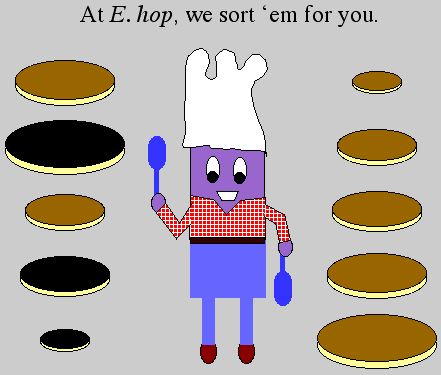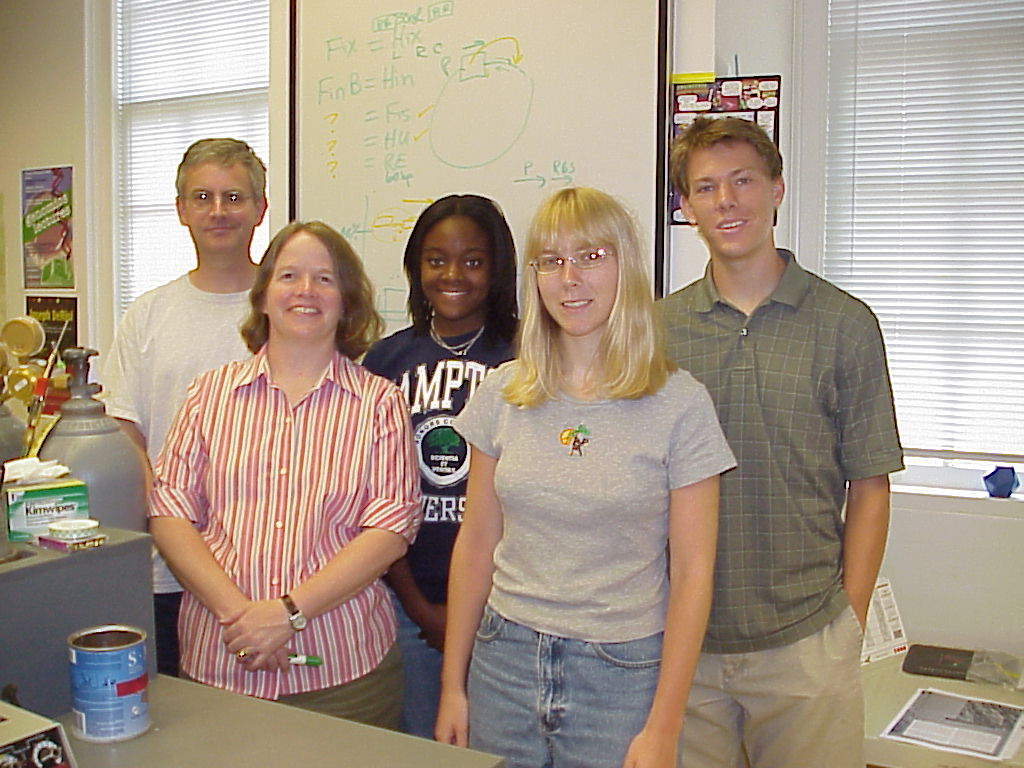Davidson 2006
From 2006.igem.org

Contents |
Students
• Sabriya Rosemond [1] is a rising junior biology major at Hampton University in VA.
• Erin Zwack [2] is a rising junior biology major at Davidson College in NC.
• Lance Harden [3] is a rising sophomore at Davidson College, who might major in math.
Faculty
• A. Malcolm Campbell [http://www.bio.davidson.edu/campbell Department of Biology], [4]
• Laurie J. Heyer [http://www.davidson.edu/math/heyer/ Department of Mathematics], [5]
Papers of Interest
• [http://www.bio.davidson.edu/courses/synthetic/papers/Sanders_04.pdf Stepwise Dissection of the Hin-catalyzed Recombination Reaction from Synapsis to Resolution. Erin R. Sanders and Reid C. Johnson]
• [http://www.molcells.org/home/journal/article_read.asp?volume=16&number=3&startpage=377 The Effects of Ethidium Bromide and Mg++ Ion on Strand Exchange in the Hin-mediated Inversion Reaction. Hee Jung Lee et al.] Excellent description of Hin recombination mechanism.
• [http://www.jbc.org/cgi/reprint/267/16/11183 The Effects of Symmetrical Recombination Site hixC on Hin Recombinase Function. Heon Man Lim et al.]
• [http://www.pubmedcentral.gov/articlerender.fcgi?tool=pubmed&pubmedid=3457367 The role of the loxP spacer region in P1 site-specific recombination. Ronald H.Hoess et al.]
• [http://www.biomedcentral.com/1471-2164/7/73 A high-throughput screen identifying sequence and promiscuity characteristics of the loxP spacer region in Cre-mediated recombination. Perseus I Missirlis et al.]
• [http://nar.oxfordjournals.org/cgi/content/full/30/13/2764 Non-contact positions impose site selectivity on Cre recombinase. Andreas W. Rufer and Brian Sauer]
• [http://www.pubmedcentral.nih.gov/articlerender.fcgi?artid=103771 Growth Phase-Dependent Variation in Protein Composition of the Escherichia coli Nucleoid]
• [http://www.jbc.org/cgi/content/full/272/29/18434 Hin-mediated Inversion on Positively Supercoiled DNA]
• [http://jb.asm.org/cgi/content/full/185/3/1097 Plasmid DNA Supercoiling and Gyrase Activity in Escherichia coli Wild-Type and rpoS Stationary-Phase Cells]
Project Description

Parts Created
Hin enhancer with biobrick ends:
gaattcgcggccgcttctagattcgggtgtcaacaattgaccaaaatatcgatttacagcgtaatgcgctttctagtgcaaattgtgaccgcattttactagttgcggccgcctgcag
- Changed the first base in bold from and "A" to a "T" to avoid the creation of a SpeI site within the enhancer which would lead to a problem when cutting the DNA because the biobricks contain a SpeI site.
Hin PCR Primers:
Left primer including biobrickends (5'->3'):
gcattctagaatggctactattgggtatattcgggtgtcaacaattgaccaaaatatcgatttacagcgtaatgcgcttacCagtgcaaattg
- The base in bold has been mutated from a "T" to a "C" to eliminate a SpeI site. Because the Hin gene codes for a protein the base substitution was chosen so that the amino acid that will form will be the same as that formed from the wild type gene.
Right Primer including biobick ends (5'-> 3'):
atgcctgcaggcggccgcactagtttaattcattcgtttttttatac
Oligoes used to make the recombinational enhancer
AATTCGCGGCCGCTTCTAGATTCGGGTGTCAACAATTGACCAAAATAT
CGATTTACAGCGTAATGCGCTTTCTAGTGCAAATTGTGACCGC
ATTTTACTAGTTGCGGCCGCCTGCA
GGCGGCCGCAACTAGTAAAATGCGGTCACAATTTGCACTAGAA
AGCGCATTACGCTGTAAATCGATATTTTGGTCAATTGTTGACACCCGAATCTAGAAGCGGCCGCG
Special Note
We feel that we should remain with Hin/Hix. We feel that we lack the appropriate knowledge of Fin/Fix. It is Hin/Hix like but maks no mention of enhancers, HU-like proteins, or fis-like proteins. Their does not seem to be any benefit to switching but would require massive research in order to find out about the unknowns. The literature might not even be out there as the papers on this mechanism are all fairly recent.
General Questions
- What is our team name and project name?
- ERIC B-RAD What is HU?AnswerEric1AnswerX1
- KELLY What is the recombinase enhancer (RE; function, sequence, usual position, relationship with HU, etc.)?Answers to this one and the next
- KELLY What sort of spacing can RE allow and still work?
- Will we need more than one RE to accomplish recombination at all positions?
- TREVOR What is FIS? Relax before you read this answer
Math Questions
- What is the problem we are solving?
- Can we determine more than just Even/Odd number of flips?
- What is the distribution of the number of flips required, if each flip is random?
- What designs might allow us to track flips made?
- Can we model the distance of RE from pancake vs. time or number of flips
- Can we model the kinetics of n flips?
- Is it possible to simulate the impact of one-time flipping lox/hix sites?
- Help us design the fewest number of constructs that will allow us to scale up the number of flips in our constructs (1, 2, 3, 4...n)
- How can we count the number of Flips? (even vs. odd only?)
- Can we use antibiotic resistence percentage (100% vs. 50% to determine number of flips for a single pancake?
- Can we create "dummy" pieces of DNA to measure rate and frequency of flipping?
- Can we create a series of target sites (e.g. LLLLL --------- RRRRRR) such that any one of several flip sites can be chosen and if hixC is dead end, we could continue flipping?
Biology Questions
- If HU and Fis are produced at high levels in E. coli, do we need high levels of Hin in order to find the Hix sites?
- Which promoter should we use? If we use Lac, then we can turn on for a long time and it will stay on. If we use maltose, then induction will reduce over time.
- Cre does not need any accessory proteins, then it may be a more efficient system to use?
- ERIN How can we turn Hin off quickly (using CRE or mutating HIX so that they stop after one reversal)?
Off answer - B-RAD Do we want to be able to turn Hin on and off more than once?AnswerS
- Should we create a transgenic E. coli with Hin and/or Cre in the chromosome so we won't need so many plasmids?
- SABRIYA Does CRE flip once and is then done with that pancake, or will it be excised the next time?
Well it seems we can stop CRE from inverting if we use two mutant LoxP sites. After they invert a wild type loxP site and a double mutant loxP site will be formed which is no longer recognizable by CRE. See Details
- ERIC How many flips would the normal negative supercoiling of a plasmid in E. coli allow? What happens to supercoiling if we make the plasmid larger? What happens to supercoiling during the stationary phase, relax? Supercoiling
- B-RAD Can we alter the amount of negative supercoiling and thus the number of flips if necessary?AnswerA
- T-ODD Can we apply EtBr to relax the number of supercoils and thus stop recombination?Answer T1
- ADAM What should we use as the reporters? Fluorescent vs. Resistant pancake or combinations? Only a few points, still unanswered if others want to add more indepth research
- Possible detection delays for both methods and how to minimize the delays
- How can we gradually scale up the number of flips with the fewest number of constructs?
- ADAM Can we use mutated lox or hix sites that will allow only single flips?Answer411
- T-ODD Will a segment flip multiple times or will the enzymes move to new sites? Answer T2
- ADAM Which version of hin are we going to use?Answer412
- Are there any antibiotic genes with biobrick ends in the registry?
Assembly Issues
- What is the list of DNA parts that we will need for the first stage, second stage, entire project?
- ERIN and SABRIYA Which DNA parts exist in the registry?Answer1More Parts
- ERIN and SABRIYAWhich DNA parts will have to be designed? Will they be synthesized or produced by PCR?
loxP sites Hin/Hix CRE gene Degradation Tags
- Which plasmids will be used from the registry?
- Where would biobricks be located?
- MALCOLM What is the protocol for assembly for the first stage (restriction digestions, ligations, transformations)?
- http://www.bio.davidson.edu/courses/Molbio/Protocols/reagents.html Common molecular reagents
- [[http://www.bio.davidson.edu/courses/Molbio/Protocols/magnesium.html PCR and Mg2+ concentration]]
- http://www.bio.davidson.edu/courses/Molbio/Protocols/pourgel.html Pouring an agarose gel
- http://www.bio.davidson.edu/courses/Molbio/Protocols/molwt.html Calculate MWs
- http://www.bio.davidson.edu/courses/Molbio/Protocols/digestion.html Digest DNA with restriction enzymes
- http://www.bio.davidson.edu/courses/Molbio/Protocols/gels2002/1kbladder.pdf 1kb MW markers
- Shrimp alkaline phosphatase URL to come
- Ligation URL to come
- http://www.bio.davidson.edu/courses/Molbio/Protocols/Promegacompcells.pdf Transformation http://www.bio.davidson.edu/courses/Molbio/Protocols/transformation.html Short version
- Promega miniprep URL to come
Current Course of Action
Plasmids
- pSB1A3
- amp resistant
- copy number:100-300
- size:2157 empty
- pSB1AC3
- part-BBAp1000
- copy number:100-3000
- amp and CmR resistant
- contains device that provides CmR
- size:3844 ( with device) 3005 (without device)
- pSB1AK3
- part BBa_|13535
- copy number:100-300
- amp and kan resistance
- contains a device for screening test
- size: 3457 (with device) 3189 (without device)
- Transform bacteria We are using Salmonella typhimurium for the Hin protein as it was the referenced species in all of the literature.
- Create RE biobrick (completed)
- Isolating genomic DNA from Salmonella typhimurium
- Ordered olioges for recombinational enhancer and primers for the hin gene
